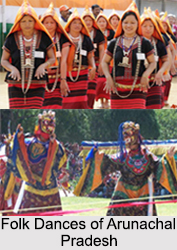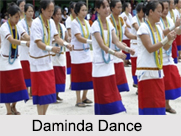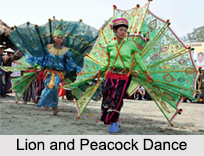 Folk Dances of Arunachal Pradesh form a vital element in the zest and joy of living of the tribal people in Arunachal Pradesh. The dances of the people of Arunachal Pradesh express their joy, love, gratitude and emotions. Most of the Folk Dances of Arunachal Pradesh are performed in traditional costumes with decorated spears and multi-coloured beads and ornaments. In Arunachal Pradesh, many dance steps resembles the moves of martial arts and some even portray highly specialized form of dance performed by the Buddhists. Dance and music are an essential part in the life of the people of Arunachal Pradesh. Most of the folk dances of Arunachal Pradesh are accompanied by chorus songs.
Folk Dances of Arunachal Pradesh form a vital element in the zest and joy of living of the tribal people in Arunachal Pradesh. The dances of the people of Arunachal Pradesh express their joy, love, gratitude and emotions. Most of the Folk Dances of Arunachal Pradesh are performed in traditional costumes with decorated spears and multi-coloured beads and ornaments. In Arunachal Pradesh, many dance steps resembles the moves of martial arts and some even portray highly specialized form of dance performed by the Buddhists. Dance and music are an essential part in the life of the people of Arunachal Pradesh. Most of the folk dances of Arunachal Pradesh are accompanied by chorus songs.
Classification of Folk Dances of Arunachal Pradesh
Folk Dances of Arunachal Pradesh can be generally classified into four different groups of dances naturally enacted for a host of purposes. They are as follows:
1. Festive Dance performances which are mostly celebration orientated folk dances celebrated in individual occasions.
2. Ritualistic Dance is another type of folk dance in Arunachal Pradesh done with much enthusiasm through certain rituals.
3. Recreational Dance is performed as part of spare time purpose. These dances are not performed as part of any ceremony or festival although they are part of firm occasions creating a happy and joyful impression.
4. Pantomimes are a Dance Drama which aims at depicting a mythological story entitled with a moral.
Different Folk Dances of Arunachal Pradesh
The folk dances of Arunachal Pradesh are as follows:
 Ponung Dance: Ponung dance falls in the celebratory dance category where the young women execute the dance holding each others" hands and moving in circles. The dance celebrates the crop season and mythological songs often relate the source of paddy and crops.
Ponung Dance: Ponung dance falls in the celebratory dance category where the young women execute the dance holding each others" hands and moving in circles. The dance celebrates the crop season and mythological songs often relate the source of paddy and crops.
Daminda Dance: This artistic dance belongs to the Apatani Tribes. It is performed during the Dree festival to celebrate the beginning of rice planting season when the people pray for a good harvest and protection from natural calamities.
Wancho Dance: Wancho Dance belongs to a particular tribe of Arunachal Pradesh. According to the name of that tribe, "Wancho" the dance is named. This dance is preformed only in special occasions like festivals and ceremonies.
Taapu Dance: This is a war dance of the Adi Tribes based on the myth of a struggling life of Tani (man) for survival. This dance is performed in order to drive out the evils from the village.
Bardo Chham: Bardo Chham is a folk dance of Arunachal Pradesh and a vital ritual among the ethno-various group of north-east people. The performers wear colourful masks and enact a fight between good and bad with music.
Khampti Dance: Khampti dance is performed during the religious festivals of Potwah, Sankian or Khamsang. This dance is practiced by the Khampti community of Arunachal Pradesh.
Buiya Dance: Buiya dance is performed on any joyful occasion like the Duiya, Tazampu and Tanuya festivals which are performed for the wealth and good health of the performer and his household. This dance may also performed after a feast arranged by a family to entertain the fellow villagers who co-operate with it opening a new field.
Rikhampada Dance: This is a medley of dances and songs collectively performed by one of the largest tribes, the Nyishi Tribes of Lower Subansiri district during the Nyokum festival. It is said that their migrated forefathers “Abotani†introduced this dance. The songs and dances are performed to honour various Gods.
 Lion and Peacock Dance: Lion and Peacock Dance is a folk dance form of Monpas, a tribe of Arunachal Pradesh. It depicts stories of animals and the dancers imitate gait and movements of the animals. Two groups participate in this dance, and each group has two drummers. The dancers wear masks resembling cock and lion heads. Gongs and cymbals accompany the dance.
Lion and Peacock Dance: Lion and Peacock Dance is a folk dance form of Monpas, a tribe of Arunachal Pradesh. It depicts stories of animals and the dancers imitate gait and movements of the animals. Two groups participate in this dance, and each group has two drummers. The dancers wear masks resembling cock and lion heads. Gongs and cymbals accompany the dance.
Aji Lhamu: It is a popular folk dance performed by Tawang"s Monpa tribe. It is a religious dance-drama much like the Hindu Epic Ramayana. The dance comprises 6 characters including a protagonist, an antagonist, two female characters, a fairy, and a mythical character.
Pasi Kongki dance: This folk dance of the Adi tribe celebrates and represents the culture of Arunachal Pradesh. The dance narrates the historical contributions by the Pasi. Both men and women perform Pasi Kongki dance while carrying a sword in their hands.
Chalo dance: The Chalo Loku festival is celebrated with Chalo dance in Arunachal Pradesh. Nocte tribe performs this dance to welcome the harvesting season. People, irrespective of age and gender can perform in this dance form.
Popir Dance: This is a recreational dance performed after the completion of important rituals of the Mopi festival. The dance is a tribute to the Mopin Ape, Goddess of prosperity and fertility.
Bardo Chham dance: This dance means "Dance of the Zodiacs" and is performed by both men and women. People of the Sherdukpens community believe that there are twelve evils like twelve zodiacs, one for each month of the year. Bardo Chham is performed to narrate this message during various regional festivities.
Idu Mishmi Dance: This is a fertility dance and ritual dance performed by Idu Mishmi people on the last day of the Rren ritual. The priests are dressed in loincloths, short-sleeved jackets, beaded necklaces and a leather bag is slung over the right shoulder. They carry a sword wearing cowry studded headbands, necklaces made with tiger teeth, and a few metal bells. The dance is accompanied by music of horn bugles and drums.
Ka Fifai Dance-Drama: It is a folk dance-drama that depicts kidnapping of a man"s daughter by spirits while she was wandering through the garden. The drama goes on to describe how the girl as rescued by the king and his soldiers.
Sadinuktso dance: This is a famous folk dance form of the Akas tribal people. It is particularly common during weddings or the construction of a new home. A group of boys or girls performs the dance while alternating a member from each group until all of the dancers have finished.



















